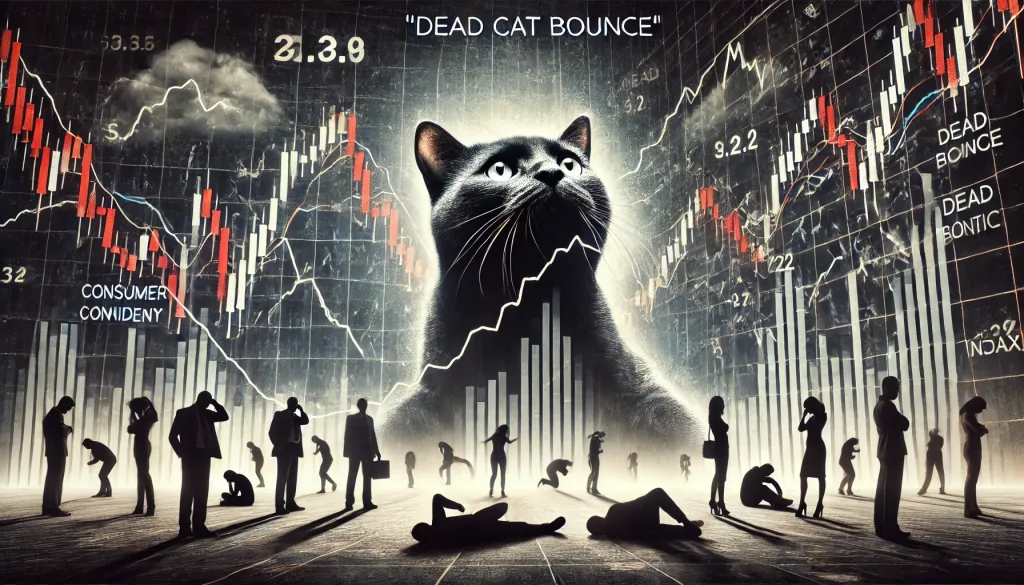Consumer Confidence Index Meets the Dead Cat Bounce: A Trader’s Survival Guide

The Market’s Mood Swings and the Cat That Won’t Stay Down
Picture this: You just got ghosted after an amazing first date. You’re staring at your phone, hoping for a text that never comes. That’s the market when the Consumer Confidence Index (CCI) drops. Traders panic, sell-offs happen, and the charts start looking like a roller coaster designed by someone with a grudge. But then—bam!—a sudden rebound. Hope returns. Is the market recovering, or is this just a dead cat bounce?
If you don’t know the difference, congratulations—you’re about to learn why most traders wipe out right at this moment.
What Is the Consumer Confidence Index (CCI), and Why Should You Care?
The Consumer Confidence Index (CCI) is like a financial mood ring, measuring how optimistic (or depressed) consumers feel about the economy. It’s compiled by The Conference Board and surveys thousands of households about their financial expectations.
Why does this matter? Because consumers drive two-thirds of the U.S. economy. If they’re confident, they spend. If they’re scared, they hoard cash like it’s an apocalypse.
How CCI Moves the Forex Market
- High Confidence → Stronger Currency: If consumers feel good, they spend more, businesses thrive, and central banks raise interest rates to control inflation. This makes the currency stronger.
- Low Confidence → Weaker Currency: When consumers stop spending, businesses suffer, and central banks cut rates to stimulate growth. This weakens the currency.
- Surprise Data → Market Whiplash: If CCI comes in way higher or lower than expected, expect volatility. This is where smart traders make (or lose) serious money.
Dead Cat Bounce: The Mirage That Tricks Traders
A dead cat bounce happens when a crashing market suddenly reverses, giving traders false hope before continuing its downward spiral. Think of it like a sugar rush before the inevitable crash.
Example: Imagine the CCI plummets, and stocks tank. Suddenly, buyers jump in, thinking prices are “cheap.” Prices rise, everyone cheers—until sellers dump again, and the market continues its downward trend.
How to Spot a Dead Cat Bounce Before It Wipes You Out
- Volume Tells the Story: If the rebound happens on low volume, it’s likely a dead cat bounce. Smart money isn’t buying—retail traders are just wishfully optimistic.
- Resistance Levels Are Key: If price bounces but fails to break key resistance levels, it’s not a real reversal.
- The News Factor: If the bad news that caused the drop hasn’t changed, the bounce is likely a trap.
- Divergence in Indicators: If the RSI or MACD shows no real momentum shift, don’t trust the rebound.
Ninja Tactics: How to Trade a Market That’s Faking You Out
1. Fade the Bounce
If you suspect a dead cat bounce, short the rally at resistance levels with a tight stop-loss. Pro tip: Use Fibonacci retracement levels to find high-probability short entries.
2. Use the Consumer Confidence Index as a Leading Indicator
If the CCI trend is declining, expect more market drops. If it’s stabilizing or rising, the sell-off might be over. Compare the CCI trend with economic data like job reports and GDP growth for confirmation.
3. Smart Risk Management
- Don’t go all in—use position sizing to manage risk.
- Set stop-loss levels based on volatility indicators like ATR.
- Hedge your trades with correlated assets (e.g., shorting stocks while going long on safe havens like gold or the yen).
Case Study: The 2008 Financial Crisis and the Ultimate Dead Cat Bounce
During the 2008 crisis, the CCI hit rock bottom in December, dropping to 38.6 (the lowest ever recorded). Markets crashed, but then came a massive fake rally in early 2009. Traders thought the worst was over—until the S&P 500 plunged another 30% before actually bottoming out in March 2009.
Lesson? A single bounce doesn’t mean recovery. Look for sustained strength in economic fundamentals before trusting a rally.
Final Takeaway: Master the Market Psychology or Get Played
Understanding the relationship between the Consumer Confidence Index and dead cat bounces is like knowing when a poker player is bluffing. If you react emotionally, you’ll get crushed. If you think like a pro, you’ll sidestep traps and make money while others panic.
Want to level up your trading game? Get real-time market insights, elite strategies, and daily trading signals with StarseedFX:
- Stay Ahead of the Curve: Latest Economic Indicators & Forex News
- Master the Market: Free Forex Courses
- Join the Elite: Exclusive Forex Community
- Upgrade Your Strategy: Smart Trading Tool
—————–
Image Credits: Cover image at the top is AI-generated
PLEASE NOTE: This is not trading advice. It is educational content. Markets are influenced by numerous factors, and their reactions can vary each time.

Anne Durrell & Mo
About the Author
Anne Durrell (aka Anne Abouzeid), a former teacher, has a unique talent for transforming complex Forex concepts into something easy, accessible, and even fun. With a blend of humor and in-depth market insight, Anne makes learning about Forex both enlightening and entertaining. She began her trading journey alongside her husband, Mohamed Abouzeid, and they have now been trading full-time for over 12 years.
Anne loves writing and sharing her expertise. For those new to trading, she provides a variety of free forex courses on StarseedFX. If you enjoy the content and want to support her work, consider joining The StarseedFX Community, where you will get daily market insights and trading alerts.
Share This Articles
Recent Articles
The GBP/NZD Magic Trick: How Genetic Algorithms Can Transform Your Forex Strategy
The British Pound-New Zealand Dollar: Genetic Algorithms and the Hidden Forces Shaping Currency Pairs
Chande Momentum Oscillator Hack for AUD/JPY
The Forgotten Momentum Trick That’s Quietly Dominating AUD/JPY Why Most Traders Miss the Signal
Bearish Market Hack HFT Firms Hope You’ll Never Learn
The One Bearish Market Hack High Frequency Traders Don't Want You to Know The

